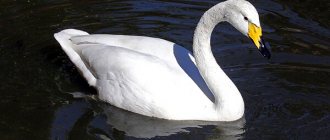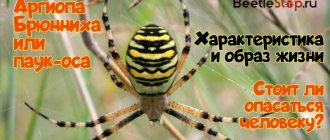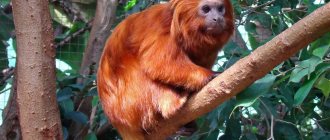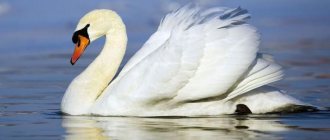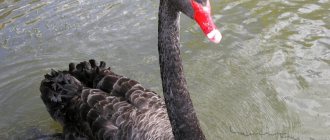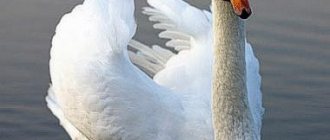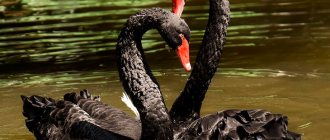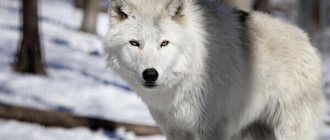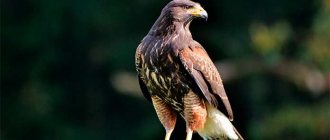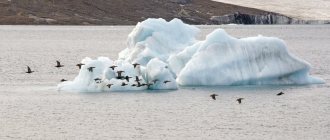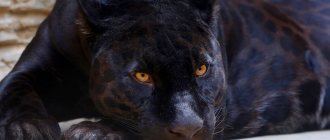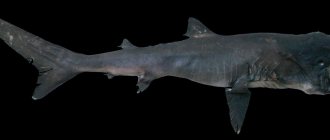The small swan is a subspecies of the American swan, but is sometimes classified as an independent species. Belongs to Eukaryotes, Chordata type, Anseriformes order, Anatidae family, Swans genus.
This is a rare bird, prone to migration. In spring it can be found from April to May. Migrates in small caravans. Even more often, alone, adjoining caravans of other swans.
Description of the subspecies
The small swan differs from its closest relatives in its modest size: the body length of an adult bird is no more than 130 cm, its wingspan can reach 180 cm. The body weight of females and males is approximately the same: five to six kilograms. Externally, it is difficult to distinguish individuals of different sexes: they have the same structure and body shape, size, and color. The plumage of an adult bird is snow-white. The feather is very dense, and the down is thick and warm.
The voice of the small tundra swan is very similar to the voice of its closest relative - the whooper, but is much quieter and differs in the uterine sound. Small tundra swans are very noisy birds: when migrating, members of the flock constantly call to each other, which can be heard many kilometers away. When landing, they make a lot of hooting sounds, and in case of fear or danger they can make very sharp, loud, trumpet-like screams. To protect their territory and chicks, they are able to make loud hissing sounds.
In their natural habitat, birds can live up to 30 years, maintaining the ability to reproduce into old age.
Photo gallery
We invite you to look at several photos of the beautiful tundra flyer in our photo gallery.
Photo 1. Bird surrounded by other birds
Photo 2. Close-up of a swan's head
Photo 3. Bird near a pond
Habitat
It is not so easy to meet a small swan: the bird lives only in remote areas of the northern part of Russia. Small populations of birds fly to the islands of Vaygach and Kolkuye, as well as the small southern islands of the Novaya Zemlya archipelago. You can rarely see birds in Taimyr and Yamal.
Conventionally, the tundra swan is divided into two subspecies:
- Oriental,
- West.
The western subspecies or population chooses the tundra strip from Taimyr to the Kola Peninsula for nesting. To the south, nesting sites extend to forest-tundra areas surrounding tributaries and the Yenisei valley. Individual pairs of birds sometimes fly to the Yugorsky and Kanin peninsulas to breed.
The eastern subspecies prefers to settle from the Chuan lowland to the Lena delta itself.
Tundra swans wintering in the Caspian Sea
Subspecies differ not only in nesting areas, but also in migration routes. The western subspecies spends the winter in European countries:
- In France,
- Ireland,
- Denmark,
- Great Britain,
- the Netherlands,
- In the south of Sweden and Norway.
Birds nesting in the south go to spend the winter on the Caspian coast:
- To Dagestan,
- Azerbaijan,
- Kazakhstan,
- Astrakhan region.
With the onset of cold weather, the eastern subspecies goes to warmer Japan, Korea, the coastal regions of China, as well as to the islands of the Sea of Japan.
little swan
Kingdom: Animalia Phylum: Chordata Class: Birds Order: Anseriformes Family: Anatidae Genus: Swans Species: Lesser swan
Scientific name - Cygnus bewickii (Yarrell, 1830)
Little swan - Cygnus bewicki Yarrell, 1830
Rarity category: 5 - recovering species. There are western and eastern populations, which some researchers give the status of subspecies. The size of the western population has recovered in part of the range, while the eastern population is recovering.
Distribution: The western population inhabits the tundra from the Pechenga valley on the Kola Peninsula to the east. to the Lena delta [1]. To the north to the Arctic coast, on Taimyr up to 74° N, south to north. parts of the forest-tundra, in the Yenisei valley up to 69° N, in the Taz valley up to 68° N. [2]. Breeds on the Kanin Peninsula, occasionally in the south. the coast of the Czech Bay, in the Malozemelskaya and Bolshezemelskaya tundra and on the Yugorsky Peninsula, along the Kara coast to the river. Baydarata [3]. In Yamal it nests from the river. Yadayakhodyyakha and Khodytayakha to the Arctic tundra [4,5], on Gydan mainly in the basin. pp. Yuribey and Totayakha [4], in the West. and Central Taimyr [6], in the interfluve of the river. Anabary and Olenek and in the Lena delta [7-9].
Lives on the islands of Kolguev, Vaygach, Novaya Zemlya, Dolgiy and Levdiev. The eastern population inhabits flat, often coastal tundras from the Lena delta to the Chaun lowland [10,11]. Breeds sporadically to the east. to Kolyuchinskaya Bay of the Chukchi Sea [12,13]. The cohabitation zone of the western and eastern populations of little swans in the Lena tundra and their taxonomic status require additional research.
Habitat: Nesting in the west. parts of the range are forb-sedge-moss and elevated swampy tundras with lakes; to the east habitat - the shores of large thermokarst lakes, replete with shallow bays overgrown with aquatic plants. A bird of open spaces, found only in the Kolyma-Alazeya interfluve for nesting and molting in the north. taiga [14]. During molting, it prefers sea bays, swampy and lowland coastal tundras, and river mouths; during migrations - sea bays, lakes, swamps; wintering areas include mixed-grass lowlands, water meadows, pastures, arable lands and inland water bodies.
Nests are made on low or dry tundra, sometimes on the shore of a reservoir, most often on an elevated area that provides a good overview of the area. Some buildings are used for a number of years, perhaps by several generations of birds [15]. The female and male incubate the clutch for 30 days. Males of the eastern population actively participate in incubation [15-17]. There are 1-6, usually 2-4 eggs in a clutch. The average brood size is 2.8 chicks. The period of growth of chicks is 45-50 days. Broods usually remain in a nesting area not exceeding 1 km2. Embryonic mortality is 8-19%, post-embryonic - 18-21%, during migration - 17-20%. The maximum life expectancy in captivity is up to 36 years, in nature up to 25 years [18]. Monogamous, forms pairs at the age of 2-4 years, the first successful reproduction of a male occurs on average at 4.6 years, females - 5.5 years; The highest productivity is in married couples under 14 years of age [18].
11-53% of the birds in the population participate in breeding. The migration range is 3000-3700 km, the survival rate of adults in wintering grounds is at least 80% [18]. It feeds on aquatic (pondweed, etc.) and terrestrial (cereals, sedges, especially roots and shoots of cotton grass, berries, potato tubers, beets, etc.) vegetation. To the east parts of the range, an indispensable component of nutrition are aquatic invertebrates (larvae and pupae of caddis flies, crustaceans) [19]. The main wintering grounds of birds of the western population are located in the Netherlands, Great Britain, Germany, Ireland and Denmark, and the wintering range is currently expanding [20-22]. In Russia they winter in the Caspian Basin. Wintering grounds of the eastern population are in China, Japan and Korea.
Number: Over the past 20-30 years, the western population within its range has increased in the European part of Russia, sharply decreased in Taimyr, in the Anabar tundra and the Lena delta; in Yamal and Gydan it fluctuates from year to year. In European tundras in 1981-1990. inhabited by 28-30 thousand individuals [3]; on Vaygach in 1985 there were 7.5 thousand [23], in 1990 - 1.1 thousand [24], in 1993 - 10-11 thousand individuals [25].
On Kolguevo in 1992 there were 200-300 individuals, on the South Island of Novaya Zemlya in 1993 - 1.5-2.5 thousand individuals [25], on the island. Dolgy in 1989 - 250 individuals [26]; on Yamal and the Gydan Peninsula, the total number in 1987 was 9.0 thousand individuals [27], on Taimyr in 1986 it did not exceed 260 individuals [6], in the Anabar tundra and the Lena delta in 1983, respectively, 100 and 710 individuals [7-9]. The western population of the little swan in Russia numbers 50-54 thousand individuals.
The highest population density is in the forb-sedge-moss coastal tundras of the European North (2.1-23 individuals/1 km2), hypoarctic and arctic tundras of Vaygach (0.5-5.1 individuals/1 km2); in the Asian part of the range - in shrub-cotton grass-moss (0.2-0.6 individuals/1 km2) and shrub-cotton grass-moss hummocky (0.01-0.3 individuals/1 km2) tundras. The molting regions within the range are constant and relatively stable in the Malozemelskaya (7-15 thousand individuals) and Bolshezemelskaya (8-12 thousand individuals) tundra.
Periodically, a large number of birds molt on the Yugorsky, Yamal and, probably, Gydansky peninsulas, Vaygach islands, Novaya Zemlya. Migrating birds make stops at Finnish Hall. (Leningrad region), Dvina Bay and the delta of the Northern Dvina, in the Malozemelskaya and Bolshezemelskaya tundras [3,28,29], in the Yamal basin. R. Shchuchya [30] and on lake. Khakassia [31].
Number of wintering little swans in 1982-1987. estimated at 16-17 thousand individuals [32,33]. More than twofold difference in population estimates in Russia and Western Europe. Europe is explained by the formation of new wintering grounds in other regions, incl. in the Caspian Basin. [21,32-34]. Apparently, only a relatively small part of the population lives east of Kolyma, numbering no more than 2000 individuals [16,35]. In the vast expanses of flat tundra west of Kolyma, the little swan is common everywhere, although not numerous. The density at nesting time of 17-20 individuals/100 km2 in the Lena delta and the Yana-Indigirsk tundra was recorded in the 60s. In the 80s - 2.2-2.8 individuals/100 km2 in the Lena delta and the Lena-Yana interfluve, 0.5-0.8 individuals/100 km2 in the Anabar-Olenek interfluve [14,36].
Wintering in Vost. About 25 thousand small swans are concentrated in Asia, of which 9-14 thousand are in Japan [37,38] and more than 10 thousand in China [37,39], 150-200 birds spend the winter on the Korean Peninsula [37] . The main limiting factors causing the reduction in numbers in certain parts of the range of the western population are economic development of territories and the associated disturbance factor, poaching in breeding grounds, wintering grounds and on flight routes, in some years unfavorable wintering conditions, predation of arctic foxes and large gulls in breeding areas. Only a small proportion of sexually mature swans arriving at breeding sites begin nesting.
Thus, the annual population growth depends primarily not on the success of nesting in a particular year, but on the number of nesting swans, which is determined by the environmental situation in the nesting territories. By now, in the north-east. In Asia, the factor of spring-summer disturbance of swans has been significantly reduced due to the outflow of the population and the reduction of reindeer husbandry in bird habitats. In the Lena delta [40], in the lower reaches of the Kolyma and to the west. Chukotka has seen an increase in the number of swans in recent years. In the coastal tundras of the Chaun Lowland in 1994, the nesting density was almost 1.5 times higher than in 1984 [41].
Protection: Listed in Appendix 2 of CITES, Appendix 2 of the Bonn Convention, Appendix 2 of the Berne Convention, Annexes of bilateral agreements concluded by Russia with the USA, India, Japan and the DPRK on the protection of migratory birds. They are protected in nesting areas in the Taimyr and Ust-Lena nature reserves, in the federal and regional nature reserves Nenetsky and Vaygachsky, and local nature reserves in the Basin. pp. Yuribey, Antipaetayakha and Messoyakha. In wintering places in the West. In Europe, especially in the UK, in addition to protection, feeding is organized. In areas of mass reproduction, molting and rest during migration, it is necessary to create a network of specially protected areas on the Kanin Peninsula, in the Pechora delta, in the Malozemelskaya and Bolshezemelskaya tundras, on the island. Vaygach, Yugorsk Peninsula, Yamal and Gydan.
Source: 1. Buturlin, 1935; 2. Stepanyan, 1990; 3. Mineyev, 1991; 4. Uspensky, Kishchinsky, 1972; 5. Danilov et al., 1984; 6. Vinokurov, 1987; 7. Blokhin, 1983; 8. Blokhin, 1984; 9. Labutin et al., 1984; 10. Ptushenko, 1952; 11. Kondratyev, 1984; 12. Lutsyuk, Sychev, 1974; Compiled by: Yu.N. Mineev, A.Ya. Kondratiev. The Red Book of Russia
Photo. Public domain, https://commons.wikimedia.org/w/index.php?curid=1530040
AOF | 04/28/2016 07:45:07
Back forward
Nutrition
Most of the diet of this beautiful waterfowl consists of food of plant origin. They feed on aquatic plants and those that they can find on land. They love to pick berries, as well as tubers of some herbs. Very often the grass around the nest is completely plucked out. Small swans also love to feast on various small invertebrates, crustaceans, and mollusks. The tundra swan differs from its fellows in that it loves to catch small fish.
Small swans prefer not to dive for food. The bird's long neck allows it to reach food even from a meter deep.
Conservation status
In recent years, the number of little swan has begun to recover, especially in the western part of its range. It currently reaches 25,000–30,000 birds , but significantly fewer nest each year. The existence of the small swan as a species currently does not cause concern - IUCN (LC), however, it is included in the Red Book of Russia as being restored.
On migration and wintering grounds, this species is protected in accordance with some international conventions (Bonn, Berne on the conservation of waterfowl) and bilateral international agreements (with the USA, Japan, India, North Korea).
Video
Reproduction
The tundra swan is a monogamous bird. A couple is formed between the ages of two and four years and remains faithful to their partner throughout their lives. If a partner dies, the second partner very often ends up creating a new couple within a few years. Birds return to their nesting sites in early spring. For nesting, the pair chooses swampy areas of the tundra, near lakes, rivers, and bays. Open water is vital for swans: it is both a source of food and an opportunity to hide from predators. Lesser swans are the most tolerant of their neighbors - nests of pairs can be located less than a kilometer from each other. But if possible, the couple prefers to settle at least two or three kilometers from the other couple.
The nest is usually built by the female. The place chosen is dry and elevated. If the place is good and rich in food, a pair of swans will return for many years. There are no more than five eggs in a clutch. Both partners take part in incubating the eggs. The chicks are born after thirty days.
From the very first day, newborns follow their parents. Very often, after all the chicks have hatched, tundra swans leave the nest and spend all their time on the water. The chicks rest and warm themselves on the backs and under the wings of their parents. Young individuals begin to fly at the age of forty-five days, which is much earlier than in any other subspecies. The young fly away for the winter with their parents and stay close until they return to the nesting sites.
Swans in myths and legends
In many countries, quite a few myths and legends are associated with the image of a swan, and the killing of a swan was condemned, punished, or promised great misfortune.
In Slavic beliefs, the main reason why a swan should not be killed was the identification of the bird with God.
In India, there is a belief that one man became a swan and, flying into the sky, merged with the sun. The snow-white bird is sacred to the people of India. According to legend, it was the female swan who laid the egg from which Brahma was born. In many regions of the country, even today there is no worse act than killing a swan.
Swans occupied a special place in Greek culture. To destroy this beautiful bird meant angering the gods and was punishable by death.
Source
Species protection
In nature, a swan has almost no enemies: the bird is very aggressive and strong.
The male is capable of killing not only feathered representatives, but also arctic foxes and young foxes. Despite this, small swans are under state protection, are listed in the Red Book and hunting them is completely prohibited. The reason for the disappearance is environmental pollution, concern from local residents, as well as widespread hunting at the beginning of the last century. Swans were easy and valuable prey, a source of tasty meat, warm down and high-quality feathers.
On the territory of Russia, quite a few nature reserves and nature parks have been organized in bird nesting areas.
Efforts to restore the population have been successful: in recent years the number has increased to 35,000.
Its unpretentiousness and beauty have made the bird quite popular for keeping in parks and zoos, which also has a positive effect on the restoration of numbers. They breed easily in captivity given enough food and space. If there is an equipped winter house and an ice-free pond, the pair will remain for the winter on their own, without clipping their wings. Despite their aggressiveness towards birds and animals, tundra swans quickly get used to humans. They are able to not only let them get close to the nest and chicks, but also willingly take food from their hands, can recognize and greet the owner with loud cries, and even beg for a treat.
Interesting facts about the animal
A pair of male tundra swans who have been living in the Moscow Zoo since 2016 may become the founders of a new large family of these birds. The enclosure for them is located in a new territory.
The staff of the institution hope that in the near future they will be able to acquire females of this species born in captivity. After all, it is impossible to remove protected animals from the wild.
Still have questions or have something to add? Then write to us about it in the comments, this will make the material more useful, complete and accurate.
